
Sparkling wine production
Encyclopedia
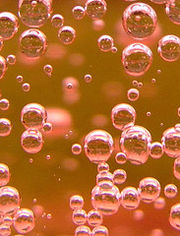
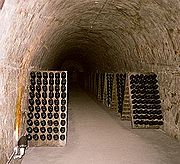
Sparkling wine
Sparkling wine is a wine with significant levels of carbon dioxide in it making it fizzy. The carbon dioxide may result from natural fermentation, either in a bottle, as with the méthode champenoise, in a large tank designed to withstand the pressures involved , or as a result of carbon dioxide...
production. The first is simple injection of carbon dioxide
Carbon dioxide
Carbon dioxide is a naturally occurring chemical compound composed of two oxygen atoms covalently bonded to a single carbon atom...
(CO2), the process used in soft drinks, but this produces big bubbles that dissipate quickly in the glass. The second is the Metodo Italiano – Charmat process, in which the wine undergoes a secondary fermentation in bulk tanks, and is bottled under pressure. This method is used for Prosecco
Prosecco
Prosecco is an Italian white wine — generally a Dry or Extra Dry sparkling wine — normally made from Glera grapes. DOC prosecco is produced in the regions of Veneto and Friuli Venezia Giulia in Italy, and traditionally mainly in the areas near Conegliano and Valdobbiadene, in the hills...
and Asti in particular, and produces smaller, longer-lasting bubbles. This is now used widely around the world to produce light, delicate sparkling wines. The third method is the traditional method or méthode champenoise. With this method the effervescence for more complex wines are produced by secondary fermentation in the bottle. As the name suggests, this is used for the production of Champagne and other quality sparkling wines, but is slightly more expensive than the Charmat process. The fourth method is the "transfer method". This method will take the cuvée
Cuvee
Cuvée is a French wine term derived from cuve, meaning vat or tank. The term cuvée is used with several different meanings, more or less based on the concept of a tank of wine put to some purpose:...
to bottle for secondary fermentation, which allows for the additional complexity, but then will transfer the wine out of the individual bottles into a larger tank after it has spent the desired amount of time on yeast.
Harvest and primary fermentation

Harvest (wine)
The harvesting of wine grapes is one of the most crucial steps in the process of winemaking. The time of harvest is determined primarily by the ripeness of the grape as measured by sugar, acid and tannin levels with winemakers basing their decision to pick based on the style of wine they wish to...
earlier, when sugar levels are lower and acid levels higher. Except for pink or rosé
Rosé
A rosé is a type of wine that has some of the color typical of a red wine, but only enough to turn it pink. The pink color can range from a pale orange to a vivid near-purple, depending on the grapes and wine making techniques.- Production techniques :There are three major ways to produce rosé...
Champagnes, the juice of harvested grapes is pressed off quickly, to keep the wine white. The first fermentation begins in the same way as any wine, converting the natural sugar in the grapes into alcohol while the resultant carbon dioxide is allowed to escape. This produces the base wine. This wine is not very pleasant by itself, being too acidic. At this point the blend, known as the cuvée
Cuvee
Cuvée is a French wine term derived from cuve, meaning vat or tank. The term cuvée is used with several different meanings, more or less based on the concept of a tank of wine put to some purpose:...
, is assembled, using wines from various vineyards, and, in the case of non-vintage
Vintage
Vintage, in wine-making, is the process of picking grapes and creating the finished product . A vintage wine is one made from grapes that were all, or primarily, grown and harvested in a single specified year. In certain wines, it can denote quality, as in Port wine, where Port houses make and...
Champagne, various years.
Traditional method
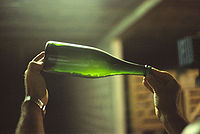
Cava (Spanish wine)
Cava is a Spanish sparkling wine of Denominación de Origen status, most of which is produced in Catalonia. It may be white or rosé. The macabeu, parellada and xarel·lo are the most popular and traditional grape varieties for producing cava...
. It used to be known as the méthode champenoise but the Champagne producers have successfully lobbied the European Union
European Union
The European Union is an economic and political union of 27 independent member states which are located primarily in Europe. The EU traces its origins from the European Coal and Steel Community and the European Economic Community , formed by six countries in 1958...
to restrict that term to wines from their region. Thus wines from elsewhere may not use méthode champenoise when sold in the EU, and instead traditional method, méthode traditionnelle or the local language equivalent can be seen. Consumers outside the EU may still see méthode champenoise on labels, but it is becoming less common.
After primary fermentation
Fermentation (wine)
The process of fermentation in wine turns grape juice into an alcoholic beverage. During fermentation, yeast interact with sugars in the juice to create ethanol, commonly known as ethyl alcohol, and carbon dioxide...
, blending (assemblage in Champagne) and bottling, a second alcoholic fermentation occurs in the bottle. This second fermentation is induced by adding several grams of yeast
Yeast
Yeasts are eukaryotic micro-organisms classified in the kingdom Fungi, with 1,500 species currently described estimated to be only 1% of all fungal species. Most reproduce asexually by mitosis, and many do so by an asymmetric division process called budding...
(usually Saccharomyces cerevisiae
Saccharomyces cerevisiae
Saccharomyces cerevisiae is a species of yeast. It is perhaps the most useful yeast, having been instrumental to baking and brewing since ancient times. It is believed that it was originally isolated from the skin of grapes...
although each brand has its own secret recipe) and several grams of rock sugar. At this time the champagne bottle is capped with a crown cap
Alternative wine closures
Alternative wine closures are substitute closures used in the wine industry for sealing wine bottles in place of traditional cork closures. The emergence of these alternatives has grown in response to quality control efforts by winemakers to protect against "cork taint" caused by the presence of...
. The bottle is then riddled (see below), so that the lees
Lees (fermentation)
Lees refers to deposits of dead yeast or residual yeast and other particles that precipitate, or are carried by the action of "fining", to the bottom of a vat of wine after fermentation and ageing. The yeast deposits in beer brewing are known as trub...
settles in the neck of the wine bottle
Wine bottle
A wine bottle is a bottle used for holding wine, generally made of glass. Some wines are fermented in the bottle, others are bottled only after fermentation. They come in a large variety of sizes, several named for Biblical kings and other figures. The standard bottle contains 750 ml,...
. After the required aging, the neck is then frozen, and the cap removed. The pressure in the bottle forces out the lees, and the bottle is quickly corked with a genuine cork to maintain the carbon dioxide
Carbon dioxide
Carbon dioxide is a naturally occurring chemical compound composed of two oxygen atoms covalently bonded to a single carbon atom...
in solution.
Second fermentation
The blended wine is put in bottles along with yeast and a small amount of sugar, called the liqueur de tirage, and stored in a wine cellarWine cellar
A wine cellar is a storage room for wine in bottles or barrels, or more rarely in carboys, amphorae or plastic containers. In an active wine cellar, important factors such as temperature and humidity are maintained by a climate control system. In contrast, passive wine cellars are not...
horizontally, for a second fermentation. Champagne requires a minimum of 1.5 years, under the Appellation d'origine contrôlée
Appellation d'Origine Contrôlée
Appellation d’origine contrôlée , which translates as "controlled designation of origin", is the French certification granted to certain French geographical indications for wines, cheeses, butters, and other agricultural products, all under the auspices of the government bureau Institut National...
, to develop completely. In years where the harvest is exceptional, a vintage (millesimé) is declared and the wine must mature for at least 3 years.
During the secondary fermentation, the carbon dioxide is trapped in the wine, in solution. The amount of added sugar determines the pressure of the bottle. To reach the standard value of 6 bars
Bar (unit)
The bar is a unit of pressure equal to 100 kilopascals, and roughly equal to the atmospheric pressure on Earth at sea level. Other units derived from the bar are the megabar , kilobar , decibar , centibar , and millibar...
(600 kPa) inside the bottle, it is necessary to have 18 grams of sugar, and the amount of yeast, Saccharomyces cerevisiae
Saccharomyces cerevisiae
Saccharomyces cerevisiae is a species of yeast. It is perhaps the most useful yeast, having been instrumental to baking and brewing since ancient times. It is believed that it was originally isolated from the skin of grapes...
, is regulated by the European Commission (Regulation 1622/2000, 24 July 2000) to be 0.3 gram per bottle. The liqueur de tirage is then a mixture of sugar, yeast and still Champagne wine.

Aging on lees
Non-vintage wine from Champagne cannot legally be sold until it has aged on the leesLees (fermentation)
Lees refers to deposits of dead yeast or residual yeast and other particles that precipitate, or are carried by the action of "fining", to the bottom of a vat of wine after fermentation and ageing. The yeast deposits in beer brewing are known as trub...
in the bottle for at least 15 months. Champagne's AOC regulations further require that vintage Champagnes be aged in cellars for three years or more before disgorgement, but most top producers exceed the requirement, holding bottles on the lees for 6 to 8 years.
Riddling
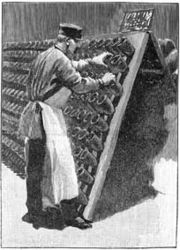
Manual riddling is still done for Prestige Cuvées in Champagne, but has otherwise been largely abandoned because of the high labour costs. Mechanised riddling equipment (a gyropalette
Gyropalette
A gyropalette is a piece of equipment used in the production of sparkling wine, such as Champagne, made by the traditional method, where the second fermentation takes place in the bottle. In order to remove the yeast sediment left in the bottle after the fermentation, riddling is performed...
) is used instead.
Many stores now sell riddling racks for decorative storage of finished wine.
Disgorging
The lees removal process is called disgorging (dégorgement in French), a skilled manual process where the crown cap and lees are removed without losing much of the liquid, and a varying amount of sugar added. Before the invention of this process by Madame Clicquot in 1816, Champagne was cloudy; this style is seen occasionally today, under the label méthode ancestrale. Modern automated disgorgement is done by freezing a small amount of the liquid in the neck and removing this plug of ice containing the lees.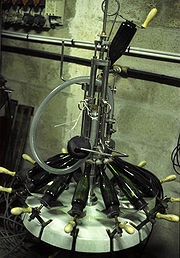
Dosage
Immediately after disgorging but before final corking, the liquid level is topped up with liqueur d'expédition, commonly a little sugar, a practice known as dosage. The liqueur d'expédition is a mixture of the base wine and sucroseSucrose
Sucrose is the organic compound commonly known as table sugar and sometimes called saccharose. A white, odorless, crystalline powder with a sweet taste, it is best known for its role in human nutrition. The molecule is a disaccharide composed of glucose and fructose with the molecular formula...
, plus 0.02 to 0.03 grams of sulfur dioxide
Sulfur dioxide
Sulfur dioxide is the chemical compound with the formula . It is released by volcanoes and in various industrial processes. Since coal and petroleum often contain sulfur compounds, their combustion generates sulfur dioxide unless the sulfur compounds are removed before burning the fuel...
as a preservative. Some maisons de Champagne (Champagne brands) claim to have secret recipes for this, adding ingredients such as old Champagne wine and candi sugar
Candi sugar
Candi sugar is a Belgian sugar commonly used in brewing, especially in stronger, Belgian beers such as dubbel and tripel. Chemically, it is an invert sugar: one that has been converted from sucrose to a mixture of fructose and glucose by heating with water and some acid...
. In the Traité théorie et pratique du travail des vins (1873), Maumené lists the additional ingredients "usually present in the liqueur d'expédition": port wine
Port wine
Port wine is a Portuguese fortified wine produced exclusively in the Douro Valley in the northern provinces of Portugal. It is typically a sweet, red wine, often served as a dessert wine, and comes in dry, semi-dry, and white varieties...
, cognac
Cognac
Cognac is a commune in the Charente department in southwestern France. It is a sub-prefecture of the department.-Geography:Cognac is situated on the river Charente between the towns of Angoulême and Saintes. The majority of the town has been built on the river's left bank, with the smaller right...
, elderberry
Elderberry
Sambucus is a genus of between 5 and 30 species of shrubs or small trees in the moschatel family, Adoxaceae. It was formerly placed in the honeysuckle family, Caprifoliaceae, but was reclassified due to genetic evidence...
wine, kirsch, framboise
Framboise
Framboise or Frambozenbier is a Belgian lambic beer that is fermented using raspberries. It is one of many modern fruitbeer types that have been inspired by the more traditional kriek beer, made using sour cherries.Framboise is usually served in a small glass that resembles a champagne glass,...
wine, alum
Alum
Alum is both a specific chemical compound and a class of chemical compounds. The specific compound is the hydrated potassium aluminium sulfate with the formula KAl2.12H2O. The wider class of compounds known as alums have the related empirical formula, AB2.12H2O.-Chemical properties:Alums are...
solutions, tartaric acid
Tartaric acid
Tartaric acid is a white crystalline diprotic organic acid. It occurs naturally in many plants, particularly grapes, bananas, and tamarinds; is commonly combined with baking soda to function as a leavening agent in recipes, and is one of the main acids found in wine. It is added to other foods to...
, and tannins.
The amount of sugar in the liqueur d'expédition determines the sweetness of the Champagne, the sugar previously in the wine having been consumed in the second fermentation. Generally, sugar is added to balance the high acidity of the Champagne, rather than to produce a sweet taste. Brut Champagne will only have a little sugar added, and Champagne called nature or zéro dosage will have no sugar added at all. A cork is then inserted, with a capsule and wire cage securing it in place.
Champagne's sugar content varies. The sweetest level is 'doux' (meaning sweet) and then, in increasing dryness, 'demi-sec' (half-dry), 'sec' (dry), 'extra sec' (extra dry), 'brut' (very dry-dry), 'extra brut' (very dry), 'brut nature/brut zero/ultra brut' (no additional sugar, bone dry).
Other methods
While the traditional, or "Champagne method", is the most widely known style of production, there are several ways to produce sparkling wine that are less costly in labor.Metodo Italiano (Charmat process)
The Charmat process is known as Metodo Charmat-Martinotti (or Metodo Italiano) in Italy, where it was invented and is most used. The wine undergoes secondary fermentation in stainless steel tanks or steel vessels covered with vitreous enamel rather than individual bottles, and is bottled under pressure in a continuous process. Many grape varieties, including Prosecco, are best suited for fermentation in tanks. Charmat method sparkling wines can be produced at a slightly lower cost than méthode champenoise wines.Sovetskoye Shampanskoye
Sovetskoye Shampanskoye
Sovetskoye Shampanskoye is a generic brand of sparkling wine produced in the Soviet Union and successor states. It was produced for many years as a state-run initiative...
or 'Soviet champagne' was produced using a similar method.
Transfer method
This follows the first steps of "methode champenoise" in that after primary fermentation the cuvée is transferred to bottle to complete secondary fermentation. When the secondary fermentation is complete and the wine has spent the desired amount of time in bottle on yeast lees (six months is the requirement to label a wine 'bottle fermented') then the individual bottles are transferred (hence the name) into a larger tank. The wine is then filtered, the liqueur de dosage added, and then filled back into new bottles for sale. This method allows for complexity to be built into the wine, but also gives scope for blending options after the wine has gone into bottle.Gas injection
Comparatively inexpensive sparkling wine is made by simple injection of CO2 from a carbonatorCarbonation
Carbonation is the process of dissolving carbon dioxide in water. The process usually involves carbon dioxide under high pressure. When the pressure is reduced, the carbon dioxide is released from the solution as small bubbles, which cause the solution to "fizz." This effect is seen in carbonated...
. This way of manufacturing is not allowed in the European Union.
Bottle aging
Even experts disagree about the effects of aging on Champagne after disgorgement. Some prefer the freshness and vitality of young, recently disgorged Champagne, and others prefer the baked apple and caramel flavors that develop from a year or more of bottle aging. In 2009, a 184-year-old bottle of Perrier-JouëtPerrier-Jouët
Perrier-Jouët is a Champagne producer based in the Épernay region of Champagne. The house was founded in 1811 by Pierre-Nicolas-Marie Perrier-Jouët, and produces both vintage and non-vintage cuvee, approximately 3,000,000 bottles annually, with its prestige label named Belle Epoque. Perrier-Jouët...
was opened and tasted, still drinkable, with notes of "truffles and caramel", according to the experts.
Vintage vs. non-vintage
The majority of the Champagne produced is non-vintage (also known as mixed vintage or multivintage), a blend of wines from several years. This means that no declared year will be displayed on the bottle labelWine label
Wine labels are important sources of information for consumers since they tell the type and origin of the wine. The label is often the only resource a buyer has for evaluating the wine before purchasing it...
. Typically, however, the majority of the wine is from the current year but a percentage is made of reserve wine from previous years. This serves to smooth out some of the vintage variations caused by the marginal growing climate of Champagne, which is the most northerly winegrowing region in France. Most Champagne houses strive for a consistent house style from year to year (largely for reasons related to price-setting and successful marketing), and this is arguably one of the hardest tasks of the house winemaker.
The grapes to produce vintage Champagne must be 100% from the year indicated (some other wines in the EU need only be 85% to be called vintage, depending on their type and appellation). To maintain the quality of non-vintage Champagne a maximum of half the grapes harvested in one year can be used in the production of vintage Champagne ensuring at least 50%, though usually more, is reserved for non-vintage wines. Vintage Champagnes are the product of a single high-quality year, and bottles from prestigious makers can be rare and expensive.
Wine faults
Several wine faultWine fault
A wine fault or defect is an unpleasant characteristic of a wine often resulting from poor winemaking practices or storage conditions, and leading to wine spoilage. Many of the compounds that cause wine faults are already naturally present in wine but at insufficient concentrations to adversely...
s can occur in sparkling wine production. Some that were present in early production methods include yeux de crapauds (toad's eyes) which was a condition of big, viscous bubbles that resulted from the wine spending too much time in wooden casks. Another fault could occur when the wine is exposed to bacteria or direct sunlight, leaving the wine with murky coloring and an oily texture.

